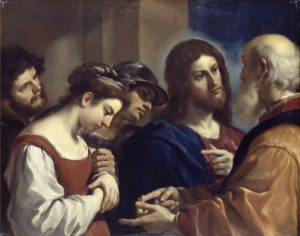August 13, 2019
The Dormition of the Theotokos
Icon
![]()
Theotokos, in the Eastern Orthodox Church, is the title of the Virgin Mary. It translates to “Mother of God” or “God-bearer”.
On August 15, we in the Western Church celebrate the Solemnity of the Assumption of Mary, body and soul, into heaven. As the bodies of the Son of God ad the Virgin Mary were united during her virginal pregnancy, and she remained physically near him during his suffering on the cross, so they were destined to be together in spirit and body eternally. Our Lady is where the whole Church is destined to be. Assumed into heaven, the Mother of God makes the Church present before the face of God.
In the Eastern Churches, August 15 is celebrated as the Dormition of Mary, or the Falling Asleep of the Virgin Mary. Whereas we celebrate the Assumption of Mary, body and soul, into heaven, the emphasis in the East is not so much an assuming of Mary’s body into heaven; rather, it is on the fact that she fell asleep from this life and woke to the next. The early Church Fathers taught that if Adam and Eve had not sinned they would not have died as we know death. Without original sin Adam and Eve would have fallen asleep then awakened to full participation in the glory of God. Our Lady’s “death” is really more like a falling asleep than it is death as we usually perceive it. The Eastern and Western Churches thus have a different emphasis.
In the above image, we see the sleeping figure of the Virgin Mary on a bier near the bottom of the frame. She is surrounded by the Apostles and followers of Christ. At her feet, St. John the Apostle leans down to be close to her, like he leaned on the breast of Jesus during the Last Supper.
Standing in the center is the figure of Jesus, holding a small figure that looks like an infant. It represents the soul of the Virgin being lifted up to heaven by her son. She is wrapped in white, symbolizing her presence in heaven.
At the top of the frame is the image of the virgin Mary in heaven, surrounded by angels. Her arms are open wide, still caring for those on earth who now make up the Mystical Body of Christ, her son, on earth.
In a typical Eastern way, the falling asleep and waking in heaven of Our Lady is depicted on the same plane in icon.
Read a reflection on the Feast of the Assumption, a holy day of obligation
June 16, 2019
Holy Trinity, Sandro Botticelli (Italian)
1491-93, Tempera on Panel
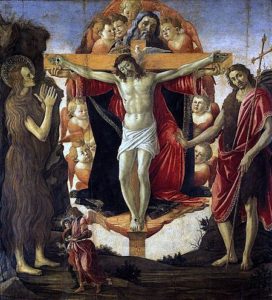
The Holy Trinity by Italian Renaissance painter Sandro Botticelli is an altarpiece commissioned by the guild of the doctors and pharmacists for the church of Santa Elisabetta delle Convertite in Florence, the church of a monastery housing and rehabilitating former prostitutes whose patron saint was Mary Magdalene.
The piece depicts the Trinity in Heaven surrounded by angels: Christ is shown still hanging on the cross, though he is in Heaven with the other Persons of the Trinity. Above his head, between him and his Father is the Dove of the Holy Spirit. God the Father is represented supporting his Son on the cross, showing that the crucifixion is part of his greater plan. It is the Trinity united in the salvation of mankind.
The Trinity is flanked by St. Mary Magdalene, praying intensely before God, and St. John the Baptist, patron saint of Florence.
In the bottom of the painting are the Archangel Raphael with Tobias, who is holding the fish that the angel told him to catch to save his father. St. Raphael was the patron of the guild of doctors and pharmacists.
May 19, 2019
Saint Rita of Cascia, Pedro Antonio Fresquis (Spanish)
1815, Water-based Paint on Wood Panel
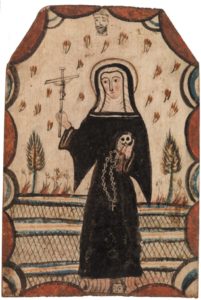
In this image, St. Rita is depicted as a religious, holding a skull and a rosary in her left hand. While living in community, St. Rita took care of the infirm Sisters and prayed for the conversion of sinners.
From childhood she was very prayerful and expressed her great desire to become a nun, but her parents arranged a marriage for her with a man who turned out to be an adulterer and monster of violence to the family and a terror to the neighbors. For 18 years she put up with him with holy patience, praying and doing penance for his conversion.
There are two men represented in the image. One above and one below St. Rita.
She had two sons who inherited their father’s violent temperament and began to follow his example. Poor Rita suffered tremendously, as they would not listen to her. She continued to pray for them with many tears.
Jesus said; “All that you ask the Father in my Name, you will receive”. Her husband converted and begged pardon of Rita for all he had made her suffer. He went to confession and just in time, because it was not long before the neighbors brought his body, covered with wounds, home to his wife. He died a victim of vengeance.
Now Rita’s sons vowed to avenge their father. Since they would not listen to her, Rita prayed to God that her sons would not become assassins. They suddenly became very sick. She lovingly took care of them in their illness. They forgave their enemies and they died.
Now a widow with no children, she dedicated her life to charity and prayer. She wanted to be a nun but the convents would only take girls who were never married. Finally, the Augustinian Sisters made an exception and allowed her to join their community. Once, her superior, to test her obedience, ordered her to water a wooden post in the garden. Rita obeyed without protest. In this image, she wears the black Augustinian habit.
Ever since she was a child she had a great devotion to the Passion and Death of Jesus. Many times while she meditated on the sufferings of Christ, as she is portrayed in the image — contemplating a crucifix in her hand, she would go into ecstasy — that is, her senses were suspended. She would neither see, hear, nor feel anything else. Once, as she was kneeling in front of the Crucifix and meditating on the Crowning of Thorns, she perceived a light like a laser come from the Cross to her head. From that time on, she carried a painful wound on her forehead, as if a thorn had pierced it. That wound would never heal during the last 14 years of her life.
In the background of the painting are fig trees on the horizon and a shower of roses. Once, when she was very sick, she asked a visitor for roses when roses were not in season. Her friend went o the garden and found roses. Another time a friend asked her if she could get her anything. She asked for figs. Again it was not time for figs, but in the garden they found the fig tree without leaves but there were figs. All these details explain why she is known as the saint of impossibilities and many people in difficult circumstances have found admirable solutions through her intercession.
St. Rita, patron of impossible cases, pray for us!
May 12, 2019
Venerable Bruno Lanteri with Madonna and Child
Unkown Artist, 20th Century
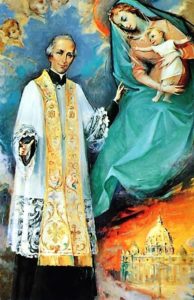
May 12, 2019 marks the 260th anniversary of the birth of Venerable Bruno Lanteri, founder of the Oblates of the Virgin Mary.
The painting, done in bold, bright colors, shows Ven. Bruno in the figure in the foreground, pointing at the viewer — calling their attention to Our Lady. Seated in Haven, she holds the baby Jesus who has his arms outstretched to the priest. Below them is the image of St. Peter’s Basilica in the Vatican, seat of the Catholic Church.
This painting is a metaphor for the charism of the Oblates of the the Virgin Mary, the congregation founded by Ven. Bruno. Father Lanteri always insisted “the Congregation of the Oblates is not my work, but the work of Mary Most Holy… She is its foundress, its mother, and its teacher.” Through the hands of Mary, the Oblates offer themselves totally to the Lord. As Father Lanteri put it, “Jesus forms the only treasure of their hearts; Jesus thus abides in their hearts and they abide in the heart of Jesus.” Emulating Christ’s meekness and humility, they desire charity and mutual friendship to be among their chief characteristics. Imitating Mary’s virtues, they pay special attention to the quality of all their actions, even the simplest tasks of daily life. Their devotion finds expression in the Oblate motto, Mariam cogita; Mariam invoca–“Think of Mary; call out to Mary.”
The image of the Vatican represents the Oblate’s professed loving and sincere fidelity to the Pope and the Magisterium of the Church. In Father Lanteri’s time, the Pope’s authority was challenged, not only by false teachings but also by political regimes. The founder wanted the Oblates “to combat forcefully any error proscribed by the Church, and to defend, even at the cost of their lives, every truth of the Catholic faith and any decision and decree of the Holy See.” The Oblates continue to serve the Church faithfully, striving for an ever more perfect fidelity to their own religious vows of poverty, chastity, and obedience. As true men of the Church, they collaborate joyfully with local bishops and pastors.
Finally, the bold colors symbolize the energy with which the Oblates dedicate themselves to the evangelization of the culture, especially through the media, and to the evangelization that happens deep within each person. They make every effort to contribute to the formation and support of priests, parish work, and missionary efforts in several countries throughout the world
May 5, 2019
Madonna and Child, Marianne Stokes (Austrian)
1905, Pastel
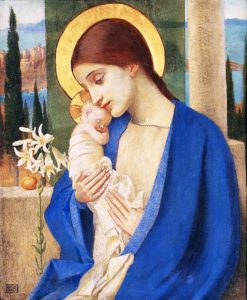
Our Lady is seated in a balcony overlooking the sea and a city in the distance. The curtain and trees behind her are still — signaling calm weather; a picture of peace. Against her chest, she cradles a sleeping infant Jesus, swaddled in cloth, as she rests her cheek on his head. This image of Mary as a loving mother with her sleeping son in her arms echoes the image of Mary as a grieving mother as she holds the limp body of her dead son after his crucifixion.
The Blessed Mother is dressed in simple clothes, a blue mantle draped over her shoulders, as is often seen in images of Our Lady. Blue was a sacred color for the ancient Jews, and a color associated with royalty. It is also the color of the sky — a heavenly color. Mary, Queen of Heaven, is usually depicted in blue.
Behind the mother and child are lilies — a symbol of purity. On the ledge of the balcony is an orange. The fruit is reminiscent of the fruit of the tree of knowledge of good and evil in the garden of Eden, and indicates that Jesus will redeem us from Original Sin. The fruit is also a symbol of new life, and thus a symbol of the Ressurection.
The May Magnificat by Gerard Manley Hopkins
April 28, 2019
Divine Mercy, Eugeniusz Kazimirowski (Lithuanian)
1934, Oil on Canvas
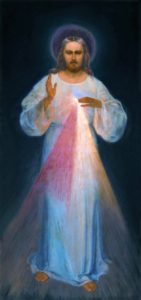
Paint an image according to the pattern you see, with the signature: Jesus, I trust in You. I promise that the soul that will venerate this image will not perish. I also promise victory over [its] enemies already here on earth, especially at the hour of death. I Myself will defend it as My own glory (Diary, 47, 48). I am offering people a vessel with which they are to keep coming for graces to the fountain of mercy. That vessel is this image with the signature: Jesus, I trust in You (327). I desire that this image be venerated, first in your chapel, and [then] throughout the world (47).
These were the words of Jesus to Sr. Faustina Kowalska, a humble Polish nun of the Sisters of Our Lady of Mercy, when he appeared to her in 1931 in Vilnius, Lithuania. With the Help of her spiritual director, St. Faustina commissioned Eugeniusz Kazimirowski to paint the original Divine Mercy image with her direction. The image shows Jesus with his right hand raised in blessing and his left hand touching his chest. Two rays – one red, one pale – shine forth from his heart. He told St. Faustina: The two rays denote Blood and Water. The pale ray stands for the Water which makes souls righteous. The red ray stands for the Blood which is the life of souls. These two rays issued forth from the depths of My tender mercy when My agonized Heart was opened by a lance on the Cross. Happy is the one who will dwell in their shelter, for the just hand of God shall not lay hold of him (299). By means of this image I shall grant many graces to souls. It is to be a reminder of the demands of My mercy, because even the strongest faith is of no avail without works (742).
When St. Faustina saw the painting, she cried in disappointment. “Who will paint you as beautiful as you are?”, she asked him(313). He answered: Not in the beauty of the color, nor of the brush lies the greatness of this image, but in My grace (313).
In one of St. Faustina’s visions, Jesus expressed his desire to have the image installed in a place of honor. In 1937, on the Sunday after Easter, the image of the Divine Mercy was consecrated and placed next to the main altar in St. Michael’s Church. The church was closed in 1948; the original image of the Divine Mercy now hangs in the Shrine of Divine Mercy in Vilnius, Lithuania.
Read the Reflection for this Sunday
Divine Mercy Novena of Masses Schedule
April 21, 2019
Three Marys at the Tomb of Christ, Ludwig Ferdinand Schnorr von Carolsfeld (Austrian)
1835, Oil on Canvas
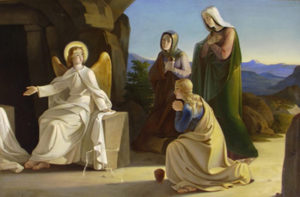
For the most part, the early Church and its artists chose not to try to represent the Resurrection. It was alluded to symbolically, but not pictured…
The earliest images that directly reference the Resurrection are those that represent the Three Marys at the Tomb. This iconography visualizes the account, found in the three synoptic Gospels, of women (two in Matthew (Matthew 28:1-7), three in Mark (Mark 16:1-8) and Luke (Luke 14:1-11), who go to the tomb early on the morning after the Passover Sabbath to complete the anointing of Jesus’ body. There they find an empty tomb and an angel messenger (or messengers in Luke) who tells them that Jesus is not there, that He has risen.
— Ad Imaginem Dei
St. Josemaria Escriva:
“Do not be terrified” was how the angels greeted the women who came to the tomb. “Do not be terrified. You are looking for Jesus of Nazareth, who was crucified. He has risen; he is not here.” “This is the day which the Lord has made; let us rejoice and be glad in it.”
Easter is a time of joy — a joy not confined to this period of the liturgical year, but to be found really and fully in the Christian’s heart. For Christ is alive. He is not someone who has gone, someone who existed for a time and then passed on, leaving us a wonderful example and a great memory.
No, Christ is alive. Jesus is the Emmanuel: God with us. His resurrection shows us that God does not abandon his own. He promised he would not: “Can a woman forget her baby that is still unweaned, pity no longer the son she bore in her womb? Even these may forget, yet I will not forget you.” And he has kept his promise. His delight is still to be with the sons of men.
Christ is alive in Christians. Our faith teaches us that man, in the state of grace, is divinized — filled with God. We are men and women, not angels. We are flesh and blood, people with sentiments and passions, with sorrows and joys. And this divinization affects everything human; it is a sort of foretaste of the final resurrection. “Christ has risen from the dead, the first-fruits of those who have fallen asleep. For since by a man came death, by a man also comes resurrection of the dead. For as in Adam all die, so in Christ all will be made to live.”
Christ’s life is our life, just as he promised his Apostles at the last supper: “If anyone love me, he will keep my word, and my Father will love him, and we will come to him and make our home with him.” That is why a Christian should live as Christ lived, making the affections of Christ his own, so that he can exclaim with St Paul: “It is now no longer I that live, but Christ lives in me.”
April 7, 2019
The Woman Taken in Adultery, Guercino (Italian)
1621, Oil on Canvas
Excerpted from St. John Paul II, Mulieris Dignitatem:
Jesus seems to say to the accusers: Is not this woman, for all her sin, above all a confirmation of your own transgressions, of your “male” injustice, your misdeeds?
The attitude of Jesus in the episode described in John 8:3-11 is significant. This is one of the few instances in which his power – the power of truth – is so clearly manifested with regard to human consciences. Jesus is calm, collected and thoughtful.
Christ did everything possible to ensure that – in the context of the customs and social relationships of that time – women would find in his teaching and actions their own subjectivity and dignity. On the basis of the eternal “unity of the two”, this dignity directly depends on woman herself, as a subject responsible for herself, and at the same time it is “given as a task” to man. Christ logically appeals to man’s responsibility. In the present meditation on women’s dignity and vocation, it is necessary that we refer to the context which we find in the Gospel. The dignity and the vocation of women – as well as those of men – find their eternal source in the heart of God. And in the temporal conditions of human existence, they are closely connected with the “unity of the two”. Consequently each man must look within himself to see whether she who was entrusted to him as a sister in humanity, as a spouse, has not become in his heart an object of adultery; to see whether she who, in different ways, is the cosubject of his existence in the world, has not become for him an “object”: an object of pleasure, of exploitation.
March 31, 2019
The Prodigal Son, Rembrandt van Rijn (Dutch)
1642, Drawing
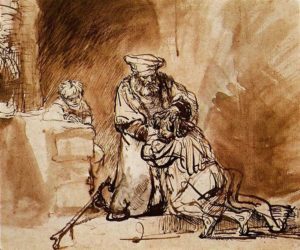
Excerpted from St. John Paul II, General Audience at the Vatican, September 8, 1999:
The merciful Father who embraces the prodigal son is the definitive icon of God revealed by Christ. First and foremost he is Father. It is God the Father who extends his arms in blessing and forgiveness, always waiting, never forcing any of his children. His hands support, clasp, give strength and, at the same time, comfort, console and caress. They are the hands of both a father and a mother.
The father’s mercy is even more apparent when he tenderly reprimands the elder brother for demanding his own rights (Lk 15: 29), and invites him to the communal banquet of joy. Mere legalism is surpassed by the father’s generous and gratuitous love, which exceeds human justice and calls both brothers to be seated again at the father’s table.
The merciful father in the parable [of the Prodigal Son] possesses and transcends all the traits of fatherhood and motherhood. In throwing himself on his son’s neck, he resembles a mother who caresses her son and surrounds him with her warmth. In the light of this revelation of the face and heart of God the Father, we can understand Jesus’ saying, so disconcerting to human logic: “There will be more joy in heaven over one sinner who repents than over ninety-nine righteous persons who need no repentance” (ibid., 15: 7). And: “There is joy before the angels of God over one sinner who repents” (ibid., 15: 10)
